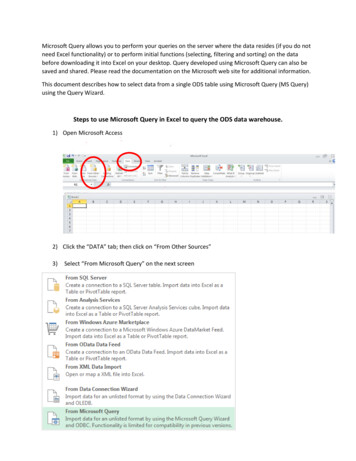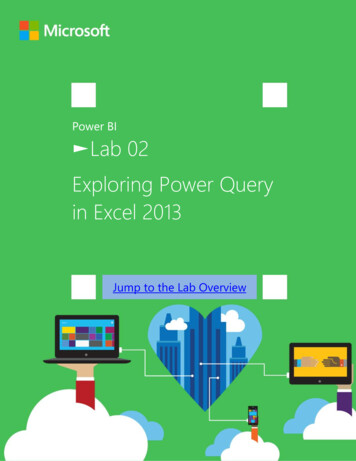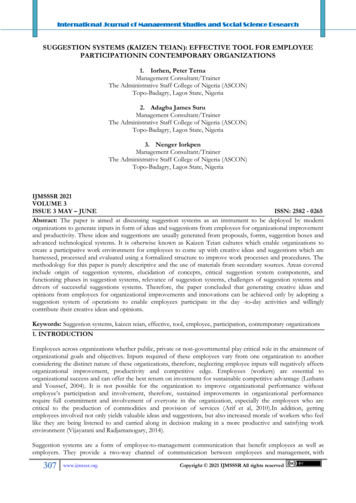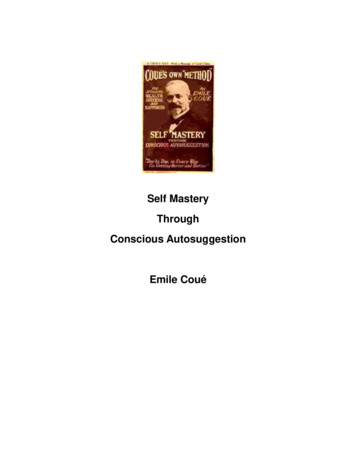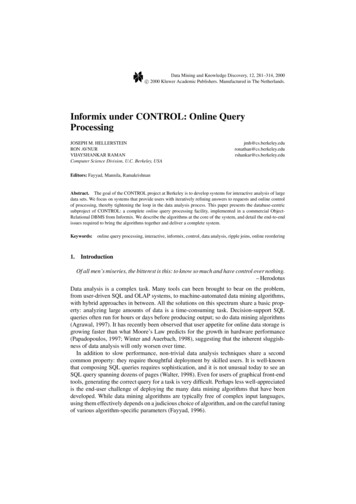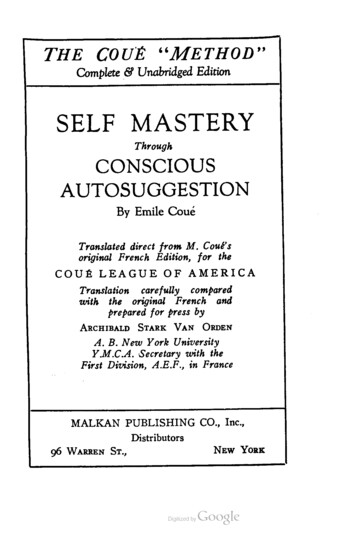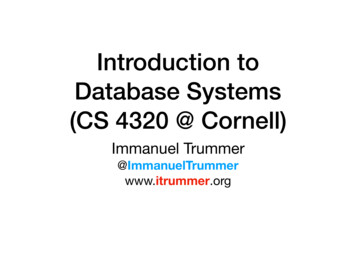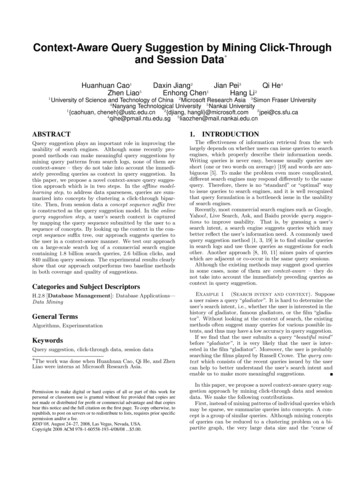
Transcription
Context-Aware Query Suggestion by Mining Click-Throughand Session Data Huanhuan Cao1Zhen Liao51Daxin Jiang2Jian Pei3Qi He412Enhong ChenHang LiUniversity of Science and Technology of China 2 Microsoft Research Asia 3 Simon Fraser University4Nanyang Technological University 5 Nankai University1{caohuan, cheneh}@ustc.edu.cn 2 {djiang, hangli}@microsoft.com 3 jpei@cs.sfu.ca4qihe@pmail.ntu.edu.sg 5 liaozhen@mail.nankai.edu.cnABSTRACT1.Query suggestion plays an important role in improving theusability of search engines. Although some recently proposed methods can make meaningful query suggestions bymining query patterns from search logs, none of them arecontext-aware – they do not take into account the immediately preceding queries as context in query suggestion. Inthis paper, we propose a novel context-aware query suggestion approach which is in two steps. In the offline modellearning step, to address data sparseness, queries are summarized into concepts by clustering a click-through bipartite. Then, from session data a concept sequence suffix treeis constructed as the query suggestion model. In the onlinequery suggestion step, a user’s search context is capturedby mapping the query sequence submitted by the user to asequence of concepts. By looking up the context in the concept sequence suffix tree, our approach suggests queries tothe user in a context-aware manner. We test our approachon a large-scale search log of a commercial search enginecontaining 1.8 billion search queries, 2.6 billion clicks, and840 million query sessions. The experimental results clearlyshow that our approach outperforms two baseline methodsin both coverage and quality of suggestions.The effectiveness of information retrieval from the weblargely depends on whether users can issue queries to searchengines, which properly describe their information needs.Writing queries is never easy, because usually queries areshort (one or two words on average) [19] and words are ambiguous [5]. To make the problem even more complicated,different search engines may respond differently to the samequery. Therefore, there is no “standard” or “optimal” wayto issue queries to search engines, and it is well recognizedthat query formulation is a bottleneck issue in the usabilityof search engines.Recently, most commercial search engines such as Google,Yahoo!, Live Search, Ask, and Baidu provide query suggestions to improve usability. That is, by guessing a user’ssearch intent, a search engine suggests queries which maybetter reflect the user’s information need. A commonly usedquery suggestion method [1, 3, 19] is to find similar queriesin search logs and use those queries as suggestions for eachother. Another approach [8, 10, 11] mines pairs of querieswhich are adjacent or co-occur in the same query sessions.Although the existing methods may suggest good queriesin some cases, none of them are context-aware – they donot take into account the immediately preceding queries ascontext in query suggestion.Categories and Subject DescriptorsH.2.8 [Database Management]: Database Applications—Data MiningGeneral TermsAlgorithms, ExperimentationKeywordsQuery suggestion, click-through data, session data The work was done when Huanhuan Cao, Qi He, and ZhenLiao were interns at Microsoft Research Asia.Permission to make digital or hard copies of all or part of this work forpersonal or classroom use is granted without fee provided that copies arenot made or distributed for profit or commercial advantage and that copiesbear this notice and the full citation on the first page. To copy otherwise, torepublish, to post on servers or to redistribute to lists, requires prior specificpermission and/or a fee.KDD’08, August 24–27, 2008, Las Vegas, Nevada, USA.Copyright 2008 ACM 978-1-60558-193-4/08/08 . 5.00.INTRODUCTIONExample 1 (Search intent and context). Supposea user raises a query “gladiator ”. It is hard to determine theuser’s search intent, i.e., whether the user is interested in thehistory of gladiator, famous gladiators, or the film “gladiator”. Without looking at the context of search, the existingmethods often suggest many queries for various possible intents, and thus may have a low accuracy in query suggestion.If we find that the user submits a query “beautiful mind ”before “gladiator ”, it is very likely that the user is interested in the film “gladiator”. Moreover, the user is probablysearching the films played by Russell Crowe. The query context which consists of the recent queries issued by the usercan help to better understand the user’s search intent andenable us to make more meaningful suggestions.In this paper, we propose a novel context-aware query suggestion approach by mining click-through data and sessiondata. We make the following contributions.First, instead of mining patterns of individual queries whichmay be sparse, we summarize queries into concepts. A concept is a group of similar queries. Although mining conceptsof queries can be reduced to a clustering problem on a bipartite graph, the very large data size and the “curse of
dimensionality” pose great challenges. We may have millions of unique queries involving millions of unique URLs,which may result in hundreds of thousands of concepts. Totackle these challenges, we develop a novel, highly scalableyet effective algorithm.Second, there are often a huge number of patterns thatcan be used for query suggestion. How to mine those patterns and organize them properly for fast query suggestionis far from trivial. We develop a novel structure of conceptsequence suffix tree to address this challenge.Third, we empirically study a large-scale search log containing 1.8 billion search queries, 2.6 billion clicks, and 840million query sessions. We explore several interesting properties of the click-through bipartite and illustrate severalimportant statistics of the session data. The data set in thisstudy is several magnitudes larger than those reported inprevious work.Last, we test our query suggestion approach on the searchlog. The experimental results clearly show that our approach outperforms two baseline methods in both coverageand quality of suggestions.The rest of the paper is organized as follows. We firstpresent the framework of our approach in Section 2 and review the related work in Section 3. The clustering algorithmand the query suggestion method are described in Sections 4and 5, respectively. We report an empirical study in Section 6. The paper is concluded in Section 7.query most likely belongs, and suggest the most popularqueries in those concepts to the user. The details aboutmining sessions, building concept sequence suffix tree, andmaking query suggestions are discussed in Section 5.Figure 1 shows the framework of our context-aware approach, which consists of two steps. The offline modellearning step mines concepts from a click-through bipartiteconstructed from search log data, and builds a concept sequence suffix tree from sessions in the data. The online querysuggestion step matches the current user’s concept sequenceagainst the concept sequence suffix tree, finds the conceptsthat the user’s next query may belong to, and suggests themost popular queries in the concepts.2.3.FRAMEWORKWhen a user submits a query q, our context-aware approach first captures the context of q which is representedby a short sequence of queries issued by the same user immediately before q. We then check the historical data andfind what queries many users often ask after q in the samecontext. Those queries become the candidate suggestions.There are two critical issues in the context-aware approach.First, how should we model and capture contexts well? Usersmay raise various queries to describe the same informationneed. For example, to search for Microsoft Research Asia,queries “Microsoft Research Asia”, “MSRA”, or “MS Research Beijing” may be formulated. Using specific queries todescribe context directly cannot capture contexts conciselyand accurately.To tackle this problem, we propose summarizing individual queries into concepts, where a concept is a small set ofqueries that are similar to each other. Using concepts todescribe contexts, we can address the sparseness of queriesand interpret users’ search intents more accurately. To mineconcepts from queries, we use the URLs clicked for queriesas the features of the queries. In other words, we mine concepts by clustering queries in a click-through bipartite. InSection 4, we will describe how to mine concepts of queries.With the help of concepts, a context can be representedby a short sequence of concepts about the queries asked bythe user in the session. The next issue is how to find thequeries that many users often ask in a particular context.It is infeasible to search a huge search log online for agiven context. We propose a context mining method whichmines frequent contexts from historical sessions in searchlog data. The contexts mined are organized into a conceptsequence suffix tree which can be searched quickly. Themining process is conducted offline. When a user context ispresented, we look up the context in the concept sequencesuffix tree to find out the concepts to which the user’s nlinePartUser Input: q1q2q3ConceptSequenceqaSuggestions: qbqc.Search Logsq11 q12q21 q22 q23q31 q32. .Concept SequenceSuffix TreeQuery SessionsFigure 1: The framework of our approach.RELATED WORKA great challenge for search engines is to understand users’search intents behind queries. Traditional approaches toquery understanding focus on exploiting information suchas users’ explicit feedbacks (e.g., [14]), implicit feedbacks(e.g., [18]), user profiles (e.g., [4]), thesaurus (e.g., [13]), snippets (e.g., [17]), and anchor texts (e.g., [12]).Several recent studies use search logs to mine “wisdom ofthe crowds” for query understanding. For example, Huang etal. [10] mined search session data for query pairs frequentlyco-occurring in the same sessions. The mined query pairswere then used as suggestions for each other. Fonseca etal. [8] and Jones et al. [11] extracted query pairs which areoften adjacent in the same sessions. The extracted adjacentquery pairs were utilized for query expansion [8] and querysubstitution [11]. We call these methods session-based approaches.Some other studies focus on mining similar queries froma click-through bipartite constructed from search logs. Thebasic assumption is that two queries are similar to each otherif they share a large number of clicked URLs. After theclustering process, the queries within the same cluster areused as suggestions for each other. We call these methods cluster-based approaches. For example, Beeferman etal. [3] applied a hierarchical agglomerative method to obtain similar queries in an iterative way. Wen et al. [19] combined query content information and click-through information and applied a density-based method, DBSCAN [7], tocluster queries. These two approaches are effective to groupsimilar queries, however, both methods have high computational cost and cannot scale up to large data. Baeza-Yates etal. [1] used the k-means algorithm to derive similar queries.The k-means algorithm requires the user to specify the number of clusters, which is difficult for clustering search logs.There are some other clustering methods such as BIRCH[21] though they have not been adopted in query under-
UserUserUserUser.ID121Time nt TypeQUERYCLICKCLICKEvent ValueKDD 0040Table 1: A search log as a stream of query and clickevents.q3q4u2u31000120u410u5standing. We find, however, those algorithms may not beable to handle the following two challenges. First, many algorithms cannot address the “curse of dimensionality” causedby the large number of URLs in logs. Second, most algorithms cannot support the dynamic update of clusters whennew logs are available.The approach developed in this paper has three critical differences from previous ones. First, unlike the existing session-based methods which only focus on query pairs,we consider variable-length contexts of queries, and provide context-aware suggestions. Second, different from thecluster-based methods, we do not simply use queries in thesame cluster as candidate suggestions for each other. Instead, we suggest queries that a user may ask next in thequery context, which are more useful than queries simplyreplaceable to the current query. Finally, instead of usingindividual queries to capture users’ search intents, our suggestion method summarizes queries into concepts.4.MINING QUERY CONCEPTSIn this section, we summarize queries into concepts. Wefirst describe how to form a click-through bipartite fromsearch log data, and then present an efficient algorithm whichcan mine from a very large bipartite.4.1Click-Through BipartiteTo group similar queries into a concept, we need to measure the similarity between queries. When a user raises aquery to a search engine, a set of URLs will be returnedas the answer. The URLs clicked by the user, called theclicked URL set of the query, can be used to approximatethe information need described by the query. We can usethe clicked URL set of a query as the set of features of thatquery. The information about queries and their clicked URLsets is available in search log data.A search log can be regarded as a sequence of query andclick events. Table 1 shows an example of a search log. Fromthe raw search log, we can construct a click-through bipartiteas follows. A query node is created for each unique query inthe log. Similarly, a URL node is created for each uniqueURL in the log. An edge eij is created between query nodeqi and URL node uj if uj is a clicked URL of qi . The weightwij of edge eij is the total number of times when uj is aclick of qi aggregated over the whole log. Figure 2 shows anexample click-through bipartite.The click-through bipartite can help us to find similarqueries. The basic idea is that if two queries share manyclicked URLs, they are similar to each other [1, 3, 19]. Fromthe click-through bipartite, we represent each query qi asan L2 -normalized vector, where each dimension correspondsto one URL in the bipartite. To be specific, given a clickthrough bipartite, let Q and U be the sets of query nodes andURL nodes, respectively. The j-th element of the featureFigure 2: An example of click-through bipartites.vector of a query qi Q is½norm(wij ) qi [j] 0where uj U and norm(wij ) if edge eij exists;otherwise,qPwij eik2wik(1).The distance between two queries qi and qj is measuredby the Euclidean distance between their normalized featurevectors. That is,sX distance(qi , qj ) ( qi [k] qj [k])2 .(2)uk U4.2Clustering MethodThere are several challenges in clustering queries effectively and efficiently in a click-through bipartite. First, aclick-through bipartite from a search log can be huge. Forexample, the data set in our experiments consists of morethan 151 million unique queries. Therefore, the clusteringalgorithm must be efficient and scalable to handle large datasets. Second, the number of clusters is unknown. The clustering algorithm should be able to automatically determinethe number of clusters. Third, since each distinct URL istreated as a dimension in a query vector, the data set is of extremely high dimensionality. For example, the data set usedin our experiments includes more than 114 million uniqueURLs. Therefore, the clustering algorithm must tackle the“curse of dimensionality”. Last, the search logs increase dynamically. Therefore, the clustering needs to be maintainedincrementally.To the best of our knowledge, no existing methods canaddress all the above challenges simultaneously. We developa new method as shown in Algorithm 1.Algorithm 1 Clustering queries.Input: the set of queries Q and the diameter threshold Dmax ;Output: the set of clusters Θ ;Initialization: dim array[d] φ for each dimension d;1: for each query qi Q do2: C-Set φ; qi do3: for each non-zero dimension d of 4:C-Set dim array[d];5: C arg minC 0 C -Set distance(qi , C 0 );6: if diamter(C {qi }) Dmax then7:C {qi }; update the centroid and diameter of C;8: else C new cluster({qi }); Θ C; qi do9: for each non-zero dimension d of 10:if C / dim array[d] then link C to dim array[d];11: return Θ;In our method, a cluster C is a set of queries.The normalP qi C qi ized centroid of the cluster is c norm(), where C
Query q C is the number of queries in C. The distance between aquery q and a cluster C is given bysX distance(q, C) ( q [k] c [k])2 ,(3)Non-zerodimensions of qDimensionArrayuk UWe adopt the diameter measure in [21] to evaluate the compactness of a cluster, i.e.,sP C P C 2i 1j 1 ( qi qj )D .(4) C ( C 1)We use a diameter parameter Dmax to control the granularity of clusters: every cluster has a diameter at mostDmax .Our method only needs one scan of the queries. We createa set of clusters as we scan the queries. For each query q,we first find the closest cluster C to q among the clustersobtained so far, and then test the diameter of C {q}. Ifthe diameter is not larger than Dmax , q is assigned to C andC is updated to C {q}. Otherwise, a new cluster containingonly q is created.The potential major cost in our method is from finding theclosest cluster for each query since the number of clusters canbe very large. One may suggest to build a tree structure suchas the CF-Tree in BIRCH [21]. Unfortunately, as shown inprevious studies (e.g., [9]), the CF-Tree structure may nothandle high dimensionality well: when the dimensionalityincreases, BIRCH tends to compress the whole data set intoa single data item.How can we overcome the “curse of dimensionality” andfind the closest cluster fast? We observe that the queries inthe click-through bipartite are very sparse. For example, inour experimental data, a query is connected with an averagenumber of 8.2 URLs. Moreover, each URL is also involved inonly a few queries. In our experiments, the average degreeof URL nodes is only 1.8. Therefore, for a query q, theaverage size of Qq , the set of queries which share at leastone URL with q, is only 8.2 · (1.8 1) 6.56. Intuitively,for any cluster C, if C Qq φ, C cannot be close to qsince the distance of any member of C to q is 2, whichis the farthest distance calculated according to Equation 2(please note that the feature vectors of queries have beennormalized). In other words, to find out the closest clusterto q, we only need to check the clusters which contain atleast one query in Qq . Since each query belongs to only onecluster in our method, the average number of clusters to bechecked is not larger than 6.56.Based on the above idea, we use a dimension array datastructure (Figure 3) to facilitate the clustering procedure.Each entry of the array corresponds to one dimension diand links to a set of clusters Θi , where each cluster C Θi contains at least one member query qj such that qj [i] 6 0.As an example, for a query q, suppose the non-zero dimen sions of q are d3 , d6 , and d9 . To find the closest cluster toq, we only need to union the cluster sets Θ3 , Θ6 , and Θ9 ,which are linked by the 3rd, the 6th, and the 9th entries ofthe dimension array, respectively. The closest cluster to qmust be in the union.Since the click-through bipartite is sparse, one might wonder whether it is possible to derive clusters by finding theconnected components from the bipartite. To be specific,two queries qs and qt are connected if there exists a queryURL path qs -u1 -q1 -u2 -. . .-qt where a pair of adjacent queryand URL in the path are connected by an edge. A clus-Clustersd1.C1d3.d6.d9.d3.d6.d9.CNCFigure 3: The data structure for clustering.ter of queries can be defined as a maximal set of connectedqueries. An advantage of this method is that it does notneed a specified parameter Dmax . However, in our experiments, we find that the bipartite is highly connected thoughsparse. In other words, almost all queries, no matter similaror not, are included in a single connected component. Moreover, the path between dissimilar queries cannot be brokenby simply removing a few “hubs” of query or URL nodes asshown in Figure 6. Thus, clusters cannot be derived fromconnected components straightforwardly.Although Algorithm 1 is efficient, the computation costcan still be very large. Can we prune the queries and URLswithout degrading the quality of clusters? We observe thatedges with low weights are likely to be formed due to users’random clicks, and should be removed to reduce noise. Tobe specific, let eij be the edge connecting query qi and uj ,and wij be the weight of eij . Moreover, let wi be the sumof the weightsof all the edges where qi is one endpoint, i.e.,Pwi j wij . We can prune an edge eij if the absolutewweight wij τabs or the relative weight wiji τrel , whereτabs and τrel are user specified thresholds. After pruninglow-weight edges, we can further remove the query and theURL nodes whose degrees become zero. In our experiments,we set τabs 5 and τrel 0.1. After the pruning process,the algorithm can run efficiently on a PC of 2 GB mainmemory for the experimental data.5.CONDUCTING QUERY SUGGESTIONSIn this section, we first introduce how to derive sessiondata from a search log. We then develop a novel structure,concept sequence suffix tree, to organize the patterns minedfrom session data. Finally, we present the query suggestionmethod based on the patterns mined.5.1Query SessionsAs explained in Section 2, the context of a user queryconsists of the immediately preceding queries issued by thesame user. To learn a context-aware query suggestion model,we need to collect query contexts from user query sessions.We construct session data in three steps. First, we extracteach individual user’s behavior data from the whole searchlog as a separate stream of query/click events. Second, wesegment each user’s stream into sessions based on a widelyused rule [20]: two consecutive events (either query or click)are segmented into two sessions if the time interval betweenthem exceeds 30 minutes. Finally, we discard the click eventsand only keep the sequence of queries in each session.Query sessions can be used as training data for querysuggestion. For example, Table 2 shows some real sessionsas well as the relationship between the queries in the ses-
Query RelationSpelling correctionPeer SN messnger MSN messengerSMTP POP3BAMC Brooke Army Medical CenterWashington mutual home loans home loansNokia N73 Nokia N73 themes free themes Nokia N73Table 2: Examples of sessions and relationship between queries in sessions.sions. We can see that a user may refine the queries orexplore related information about his or her search intentin a session. As an example, from the last session in Table 2, we can derive three training examples, i.e., “NokiaN73 themes” is a candidate suggestion for “Nokia N73”, and“free themes Nokia N73” is a candidate suggestion for bothsingle query “Nokia N73 themes” and query sequence “NokiaN73 Nokia N73 themes”.5.2Concept Sequence Suffix TreeQueries in the same session are often related. However,since users may formulate different queries to describe thesame search intent, mining patterns of individual queriesmay miss interesting patterns. To address this problem, wemap each session qs q1 q2 · · · ql in the training data intoa sequence of concepts cs c1 c2 · · · cl , where a concept ciis represented by a cluster Ci derived in Section 4.2 anda query qi is mapped to ci if qi Ci . If two consecutivequeries belong to the same concept, we record the conceptonly once in the sequence.How can we mine patterns from concept sequences? Astraightforward method can first mine all frequent sequencesfrom session data. For each frequent sequence cs c1 . . . cl ,we can use cl as a candidate concept for cs0 c1 . . . cl 1 . Wethen can build a ranked list of candidate concepts c for cs0based on their occurrences following cs0 in the same sessions;the more occurrences c has, the higher c is ranked. For eachcandidate concept c, we can choose from the correspondingcluster C the member query which has the largest numberof clicks as the representative of c. In practice, we only needto keep the representative queries of the top K (e.g., K 5)candidate concepts. These representative queries are calledthe candidate suggestions for sequence cs0 and can be usedfor query suggestion when cs0 is observed online.The major cost in the above method is from computingthe frequent sequences. Traditional sequential pattern mining algorithms such as GSP [16] and PrefixSpan [15] can bevery expensive, since the number of concepts (items) andthe number of sessions (sequences) are both very large. Wetackle this challenge with a new strategy based on the following observations. First, since the concepts co-occurringin the same sessions are often correlated in semantics, theactual number of concept sequences in session data is far lessthan the number of possible combinations of concepts. Second, given the concept sequence cs c1 . . . cl of a session,since we are interested in extracting the patterns for querysuggestion, we only need to consider the subsequences withlengths from 2 to l. To be specific, a subsequence of the concept sequence cs is a sequence c1 i , . . . , cm i , where i 0and m i l. Therefore, the number of subsequences to be. Finally, the average numconsidered for cs is only l·(l 1)2{}C1C2C1 C3C1C2C3C4C1C1C3 C6C3C2C3C1 C4C3C1C4C1C5C5C2C5C7C5C9C2C5Figure 4: A concept sequence suffix tree.Algorithm 2 Building the concept sequence suffix tree.Input: the set of frequent concept sequences CS and the numberK of candidates;Output: the suffix concept tree T ;Initialization: T .root ;1: for each frequent concept sequence cs c1 . . . cl do2: cn findNode(c1 . . . cl 1 , T );3: minc argminc cn.candlist c.f req;4: if (cs.freq minc.freq) or ( cn.candlist K) then5:add cl into cn.candlist; cl .freq cs.freq;6:if cn.candlist K then remove minc from cn.candlist;7: return T ;Method: findNode(cs c1 . . . cl , T );1: if cs 0 then return T .root;2: cs0 c2 . . . cl ; pn findNode(cs0 , T ); cn pn.childlist[c1 ];3: if cn null then4: cn new node (cs); cn.candlist φ; pn.childlist[c1 ] cn;5: return cn;ber of concepts in a session is usually small. Based on theseobservations, we do not enumerate the combinations of concepts, instead, we enumerate the subsequences of sessions.Technically, we implement the mining of frequent conceptsequences with a distributed system under the map-reduceprogramming model [6]. In the map operation, each machine (called a process node) receives a subset of conceptsequences as input. For the concept sequence cs of a session, the process node outputs a key-value pair (cs0 , 1) to abucket for each subsequence cs0 with a length greater than1. In the reduce operation, the process nodes aggregate thecounts for cs0 from all the buckets and output a key-valuepair (cs0 , f req) where f req is the frequency of cs0 . A concept sequence cs0 is pruned if its frequency is smaller thana threshold.Once we get the frequent concept sequences, we organizethem into a concept sequence suffix tree (Figure 4). Formally,a (proper) suffix of a concept sequence cs c1 . . . cl is anempty sequence or a sequence cs0 cl m 1 . . . cl , wherem l (m l). In a concept sequence suffix tree, each nodecorresponds to a frequent concept sequence cs. Given twonodes csi and csj , csi is the parent node of csj if csi is thelongest proper suffix of csj . Except the root node whichcorresponds to the empty sequence, each node on the tree isassociated with a list of candidate suggestions.Algorithm 2 describes the process of building a conceptsequence suffix tree. Basically, the algorithm starts fromthe root node and scans the set of frequent concept sequences once. For each frequent sequence cs c1 . . . cl ,the algorithm first finds the node cn corresponding to cs0 c1 . . . cl 1 . If cn does not exist, the algorithm creates a newnode for cs0 recursively. Finally, the algorithm updates thelist of candidate concepts of cs if cl is among the top Kcandidates observed so far.
Algorithm 3 Query suggestion.Input: the concept sequence suffix tree T and user input querysequence qs;Output: the ranked list of suggested queries S-Set;Initialization: curN T .root; S-Set φ;1: map qs into cs;2: curC the last concept in cs;3: while true do4: chN curN ’s child node whose first concept is curC;5: if (chN null) then break;6: curN chN ; curC the previous concept of curC in cs;7: if (curC null) then break;8: if curN ! T .root then9: S-Set curN ’s candidate suggestions;10: return S-Set;In Algorithm 2, the major cost for each sequence is fromthe recursive function findNode, which looks up the node cncorresponding to c1 . . . cl 1 . Clearly, the recursion executesat l 1 levels. At each level, the potential costly operationis the access of the child node cn from the parent node pn(the last statement in line 2 of Method findNode). We use aheap structure to support the dynamic insertion and accessof the child nodes. In practice, only the root node has alarge number of children, which cannot exceed the numberof concepts NC ; while the number of children of other nodesis usually small. Therefore, the recursion takes O(log NC )time and the whole algorithm takes O(Ncs · log NC ) time,where Ncs is the number of frequent concept sequences.5.3Online Query SuggestionSuppose the system receives a sequence of user input queriesq1 · · · ql . Similar to the procedure of building training examples, the query sequence is also mapped into a conceptsequence. However, unlike the queries in the training examples, an online input query
mining query patterns from search logs, none of them are context-aware { they do not take into account the immedi-ately preceding queries as context in query suggestion. In this paper, we propose a novel context-aware query sugges-tion approach which is in two steps. In the o†ine model-learning step, to address data sparseness, queries are sum-
